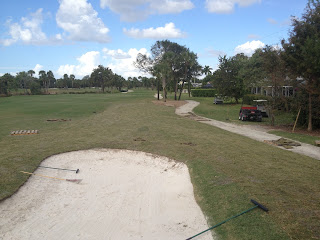Colder Weather Will Trigger Disease Development, Downy Mildews and Turf Disease...
If you are inclined to try impatiens again for your flower beds...DON'T! Resist that temptation!
Remember last January when there was a rampant and sudden loss of most impatiens plantings in south Florida? Still, impatiens are unashamedly being sold at certain locations. But recall the epidemic we had last year! The spores of this water mold are probably in 4 out of 5 landscape soils now . Cornell University's plant pathologist, Margery Daughtrey, reports that, " ...32 states were affected this year (2012); that means all the eastern ones (except for WV, which must not have been looking) and the 3 coastal states on the west coast. "
Symptoms include, slight marginal, cupping of leaves and eventual defoliation. A powdery growth occurs on the underside of the leaves. The pathogen is not a true fungus, rather it is similar to the water molds, so typical fungicides aren't effective. Some fungicides may help minimize infection, but after the plant is infected it is too late. It is not recommended to plant impatiens until this is all sorted out. See fact sheets (search for "annuals") at our local web site (http://collier.ifas.ufl.edu) for alternative short plants for color(New Guinea impatiens, geraniums, begonias, lantanas, bromeliads, etc).
However, alternative plant species, that I am aware of, don’t offer the range of salmon, purple and lavender flower hues of impatiens. Impatiens require considerable water to keep them vigorous, so maybe their loss will save some aquifer depletion. Fortunately, the downy mildew pathogen, Plasmopara obducens, doesn't bother other plant species.
Please see a nation-wide compilation of information at this American Floral Endowment web site: http://tinyurl.com/8o3yr59 and also our local Youtubevideo on this: http://tinyurl.com/9pvlp8m .
Awabuki viburnum downy mildew disease and large (brown) patch disease of turfgrasses will be activated with the recent cooler weather. Diseases are difficult to manage once they get a toe-hold. So if you have an area with a history of the disease, contact your landscape maintenance company or you should consider applying the fungicides as a preventive (for turf & viburnum diseases) once the weather is favorable for disease development, which means now with the cooler night temperatures we had this (week of October 26) ! We have separate fact sheets at our web site on managing these cool season diseases (http://collier.ifas.ufl.edu) as well as our Youtube videos (http://tinyurl.com/d4e3er2) .
Doug Caldwell, Ph.D., “helping you beautify your landscape and protect the environment”, is the commercial landscape horticulture extension educator and landscape entomologist with the University of Florida Collier County Extension Service. The Cooperative Extension Service is an off-campus branch of the University of Florida, Institute of the Food and Agricultural Sciences and a department of the Public Services Division of Collier County government. E-mail, dougbug@ufl.edu .
"Helping you beautify your landscape and protect the environment!"

















